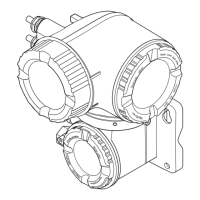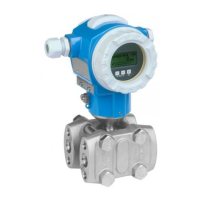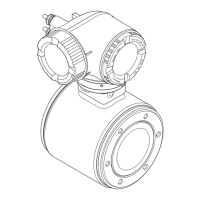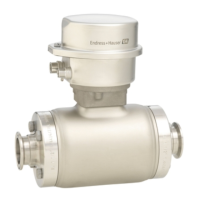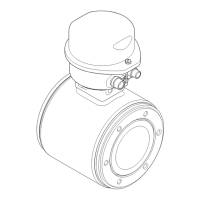Proline t-mass I 300 HART Commissioning
Endress+Hauser 113
Parameter overview with brief description
Parameter Description Selection
Device reset Reset the device configuration - either entirely or in part - to a
defined state.
• Cancel
• To delivery settings
• Restart device
• Restore S-DAT backup
*
* Visibility depends on order options or device settings
9.5.7 In-situ adjustment
In-situ adjustment is used to adjust the flow output by the measuring device to the real
flow of the facility. Flow profiles can be distorted by facility parts such as pipe elbows,
extensions, reductions or valves. A distorted flow profile can, in turn, negatively impact the
accuracy of the measuring device. By taking into consideration the actual process-specific
conditions at the facility, including any effects from installation, in-situ adjustment
provides flow display that is adapted to the local conditions.
In-situ adjustment can lead to better measurement results in the following cases:
• Process-specific facility conditions / installation effects
• If the flow profile is distorted
• For unfavorable inlet and outlet conditions
• If the gas is unknown
• If it is not possible to use a flow conditioner to rectify the distorted flow profile
• If process conditions deviate significantly from reference conditions (pressure and
temperature conditions of factory calibration)
• Third-party adjustments with the process gas actually used
In-situ adjustment has the following specific features:
• Can be used for both unidirectional and bidirectional sensors
• Can be defined for up to 16 flow points (for the entire operating range)
• At least one flow point is required for the adjustment but the general principle is that
the more flow points that are defined, the better the measuring performance
• Measuring device can be configured without interrupting the process
• The measuring device takes account of the choice of process gas and the actual process
conditions during the measurement
• The flow value can be entered manually via a display or an operating interface, or a flow
value from a reference device can be read into the measuring device via a current input
or bus communication
Prerequisites for optimum in-situ adjustment
• The accuracy of the flow reference used determines the performance of the measuring
device adjusted in-situ. For this reason, the use of a reference device with a traceable
calibration is recommended
• Calibration points all at the same temperature and pressure conditions
• Compositions of gases or gas mixtures are made available to the measuring device as
these compositions are used for pressure and temperature compensation
• Precise pressure specifications are important if a volume flowmeter is used as the
reference device
• If the flow values are indicated in corrected volume flow, it is important that the
standard reference conditions in the reference device and in the device are identical
• For optimum results, it is advisable to use a reference device with traceable
calibration for the adjustment.
• If a reference device is not available, a fan characteristic curve, for example, can act as the reference instead.

